
Original Link: https://www.anandtech.com/show/4466/cooler-masters-storm-enforcer-the-notsoquiet-storm
Cooler Master's Storm Enforcer: The Not-So-Quiet Storm
by Dustin Sklavos on July 5, 2011 5:39 PM EST- Posted in
- Cases/Cooling/PSUs
- Cooler Master
- Storm Enforcer
Introducing the Cooler Master Storm Enforcer
It's a treat to get one of Cooler Master's enclosures in for review: they've been at it for a long time, and they have cases that cover virtually every price point on the market. They manufacture my personal favorite Micro-ATX budget enclosure, the Elite 360, an attractive $40 devil that makes for a fantastic budget HTPC case. They're also responsible for the crowd favorite enthusiast juggernaut, the Cosmos. What we have in today isn't the beast the Cosmos is, but it's not the pint size player the Elite 360 is either. From their Storm series of gaming cases we have the Enforcer. At an MSRP of $79 it lands right between our incumbent In-Win BUC and the budget ninja BitFenix Shinobi. Can it beat them both?
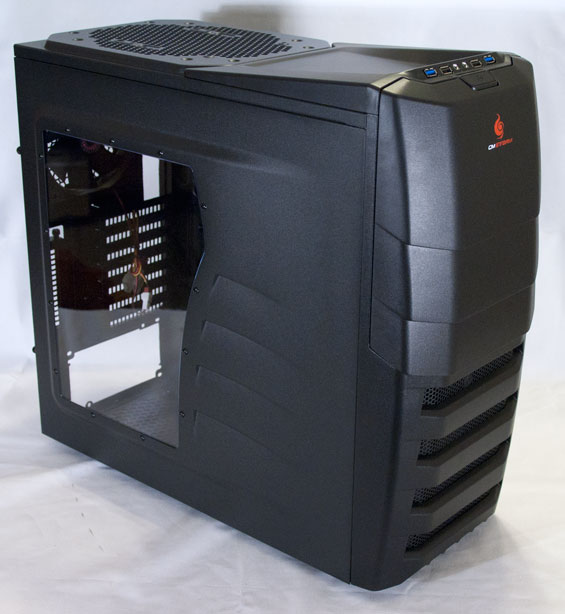
I wound up reviewing the Enforcer fresh off of working with the BitFenix Shinobi, so that entrant is still fresh in my mind. Opening the box and pulling out the Enforcer made me again feel refreshed to see that an inexpensive case doesn't necessarily mean "cheap;" while it's $10 more than the Shinobi, opening the case and poking around its insides revealed a modern design with more than a few thoughtful touches that we'll discuss in greater detail in just a bit. But first, the specs:
| Cooler Master Storm Enforcer Specifications | ||
| Motherboard Form Factor | ATX, Micro ATX, Mini ITX | |
| Drive Bays | External | 4x 5.25" (includes 5.25"-to-3.5" external bay adapter) |
| Internal | 6x 3.5", 2x 2.5" (includes adapter to add two additional 2.5" bays in 3.5" bay) | |
| Cooling | Front | 1x 200mm red LED intake fan (3-pin header w/ molex adaptor) |
| Rear | 1x 120mm exhaust fan (3-pin header w/ molex adaptor) | |
| Top | 2x 120mm or 1x 200mm fan mount | |
| Side | - | |
| Bottom | - | |
| Expansion Slots | 7 normal plus 1 for fan controller/extra ports | |
| Front I/O Port | - | |
| Top I/O Port | 2x USB 2.0, 2x USB 3.0, headphone and mic jacks | |
| Power Supply Size | ATX | |
| Clearance | 15" without drive cage/11" with drive cage (Expansion Cards), 175mm (CPU HSF), 290mm without 2.5" drive cage/180mm with 2.5" drive cage (PSU) | |
| Weight | 19.5 lbs. | |
| Dimensions | 20.6" x 9.0" x 19.0" | |
| Price | $79 | |
The Enforcer also has a door that covers the external drive bays with a hinge on the right-hand side, which actually struck me as a little unusual since the Antec cases I've tested all hinged on the left. It's a minor point in the grand scheme of things, what may be less minor is the way the Enforcer supports USB 3.0: this is the first enclosure I've tested that uses the USB 3.0 motherboard header instead of just running a pass-through to the back of the case. Cooler Master includes a slotted expansion bay cover expressly for routing an adaptor cable to the back, but unfortunately the Enforcer doesn't include that cable, so if your motherboard is decidedly old school that way (since when did USB 3.0 become old school?) you'll have to buy it separately.
In and Around the Cooler Master Storm Enforcer
For how gaudy gaming cases can often be (and I'll readily admit the excellent In-Win BUC certainly falls into this category), the Cooler Master Storm Enforcer is actually fairly tame. While it's not liable to win any beauty contests standing next to BitFenix's Shinobi or Antec's Sonata series, it isn't aggressively hideous either, with the curves being at least presentable. The red LED fan in the front isn't too bright, and the window is in about the right place.
Things do get a little bit silly from the word "go" though. When you open the hinged drive bay door, you'll see the four external bays feature ventilated covers. This is useful ventilation that barrels directly into the processor's tower cooler, but the door isn't ventilated in any way, essentially preventing enough air from at least passively entering the front. Instead intake is taken care of by the 200mm fan below the drive bays, and as you'll see when we get to benchmarks...between this one and the ones in the Corsair 600T, I'm none too impressed with these giant fans.
The main side panel is fastened using thumbscrews while the back panel uses standard screws, and it seems like thumbscrews should've been used in both places since the case is designed to allow you to route cables behind the motherboard tray. When you do open things up, though, you find a remarkably spacious and well thought out interior with virtually every modern convenience.
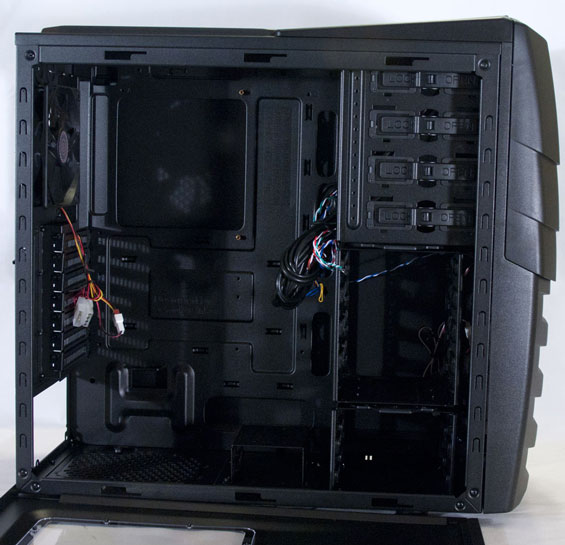
There's a generously sized cutout in the motherboard tray for those of us having to suffer with compensating for Intel's dire heatsink mounting system, along with holes around the motherboard for routing cables including a much appreciated one above the motherboard specifically for that frustrating AUX 12V line. The area above the motherboard is also fairly spacious; there's room for installing a single 200mm fan or two 120mm fans, but I'd almost be inclined to leave it open just to make cabling a little easier. Besides, the native configuration of the Enforcer is a positive pressure design which has become vogue as of late.
Although in a perfect world there'd be eight expansion slots in a column (I keep my second video card hanging off the last slot on my board to allow the top card better airflow), the seven is the norm and the "auxiliary" one above them is a nice touch. SilverStone's GD04 has a similar feature and it's actually quite welcome, as I mounted a fan controller in that case. The Enforcer isn't liable to need a fan controller, though: both fans have 3-pin leads attached to molex adaptors. If you didn't make the mistake of buying a Gigabyte board with BIOS level fan controls that could be considered archaic at best (like mine), your motherboard should be able to handle these just fine. Life without molex connectors is sweet.
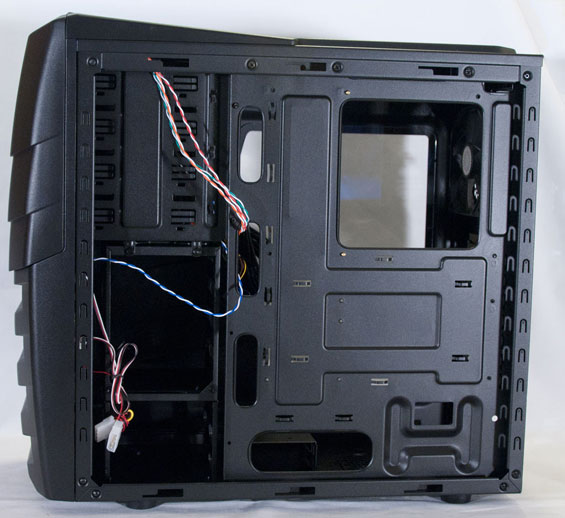
Just below the expansion slots is the power supply bay at the bottom of the case, capable of handling the power supply in its regular orientation or upside-down; depending on your power supply's cabling and whether or not you use the included removable 2.5" drive cage, you may very well have to flip the power supply to keep the cables from butting up against the cage. That drive cage is also one of my favorite features of the Enforcer and it's something I spotted when I reviewed the War Factory Sentinel desktop last month, which used a Cooler Master HAF 912. It can handle two 2.5" drives which should be just enough for a modern build.
The 3.5" drive bays are oriented with the connectors for the drives facing behind the motherboard tray to allow for both easy cable routing and easy drive installation. 3.5" drives are installed using rails that snap into the mounting holes on the drive, and from there the drive slides in and locks into place. It's simple and painless and the drive is secure. 5.25" drives are mounted using a different toolless mechanism: each drive bay has a toggle on it that switches between "open" and "lock," and it works as advertised. If the drive still feels a little loose (ours did) you can secure it using screws.
Assembling the Cooler Master Storm Enforcer
Actually putting together the Cooler Master Storm Enforcer was nearly as painless as the BitFenix Shinobi was, a welcome change of pace before I get into the more complex enthusiast-class Thermaltake Level 10 GT and SilverStone Raven RV-03 next month. Cooler Master includes a multilingual instruction manual and a host of adaptors, screws, and zip-ties, but most of the assembly was fairly self-explanatory.
The Enforcer includes just two motherboard standoffs installed by default and I'd honestly have liked to see all of the standoffs for ATX installed from the get-go, but it's a minor nuisance and Cooler Master includes a handy phillips-to-socket adaptor for screwing in the standoffs. Our testbed has been in and out of so many cases now that getting it and the I/O shield installed snugly was a breeze. Connecting front panel headers was likewise simple. A refreshing change of pace from the BitFenix Shinobi and NZXT H2, the headers are brightly color-coded. Unfortunately Cooler Master doesn't include an adaptor for turning the USB 3.0 motherboard header cable into a pass-through, so that cable wound up getting hidden behind the motherboard tray while the USB 3.0 ports sit lifelessly at the top of the chassis. There's also a separate PC speaker included that's not built into the case.
Removing the 2.5" drive cage was easy enough, but installing the SSD was slightly comical. The screws included for mounting the SSD are just a little bit fat, and though it did mount fine there was some...manipulation involved. A couple of screws may or may not have been launched off of the table. Still, you can install the drive with the connectors facing a convenient opening in the tray, and even when I went to route cables it was still fairly easy to connect the SSD.
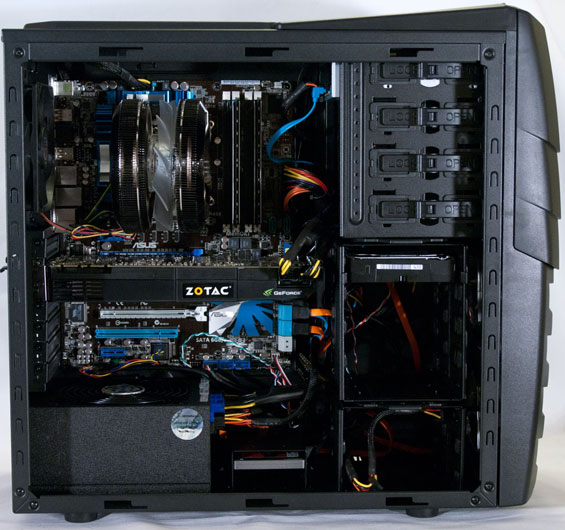
Installing the optical drive and hard drive were an absolute breeze. The rails for the HDD snapped into place, then the drive slid and locked into the cage, and everything was golden. The shields for the 5.25" external bays are also extremely easy to remove: slip your hand into the drive cage and pinch the sides of the shield, and it'll pop right out. From there, move the switch on the bay to "open", slide the drive in, line up the mounting holes, and switch it back to "lock." So simple. Clearance for installing our GeForce GTX 580 was actually perfectly fine, too, but you can remove the middle 3.5" drive cage if you need to install a monster like a Radeon HD 6990.
Where things did get a little bit slippery was with the power supply. Due to the position of the 2.5" drive cage combined with where the modular connectors are on our testbed power supply, the PSU had to actually be installed inverted, with the intake fan facing up inside the case. The back of the Enforcer supports installing power supplies in this orientation, but it's not ideal. Routing the power cables was easy enough, though, and the routing hole and extra clearance at the top of the case for the AUX 12V cable was a godsend.
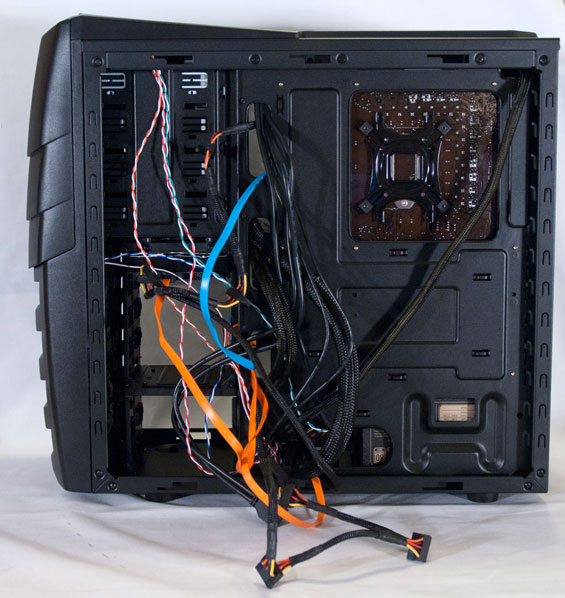
Unfortunately, getting the side panels back on was another matter entirely. There's space behind the motherboard tray for routing cables, but if a molex or SATA power connector can't fit back there it's not enough. The BitFenix Shinobi had stellar clearance and some of In-Win's cases are just as generous, but the Enforcer required me to move the excess SATA power cables into one of the bottom drive bays before I could force the back panel on.
Testing Methodology
For testing ATX cases, we use the following standardized testbed in stock and overclocked configurations to get a feel for how well the case handles heat and noise.
| Full ATX Test Configuration | |
| CPU |
Intel Core i7-875K (95W TDP, tested at stock speed and overclocked to 3.8GHz @ 1.38V) |
| Motherboard | ASUS P7P55D-E Pro |
| Graphics Card | Zotac NVIDIA GeForce GTX 580 (244W TDP) |
| Memory | 2x2GB Crucial Ballistix Smart Tracer DDR3-1600 |
| Drives |
Kingston SSDNow V+ 100 64GB SSD Western Digital Caviar Black 1TB SATA 6Gbps Samsung 5.25" BD-ROM/DVDRW Drive |
| CPU Cooler | Zalman CNPS9900 MAX with Cooler Master ThermalFusion 400 |
| Power Supply | SilverStone Strider Gold 750W 80 Plus Gold |
A refresher on how we test:
Acoustic testing is standardized on a foot from the front of the case, using the Extech SL10 with an ambient noise floor of ~32dB. For reference, that's what my silent apartment measures with nothing running, testing acoustics in the dead of night (usually between 1am and 3am). A lot of us sit about a foot away from our computers, so this should be a fairly accurate representation of the kind of noise the case generates, and it's close enough to get noise levels that should register above ambient.
Thermal testing is run with the computer having idled at the desktop for fifteen minutes, and again with the computer running both Furmark (where applicable) and Prime95 (less one thread when a GPU is being used) for fifteen minutes. I've found that leaving one thread open in Prime95 allows the processor to heat up enough while making sure Furmark isn't CPU-limited. We're using the thermal diodes included with the hardware to keep everything standardized, and ambient testing temperature is always between 71F and 74F. Processor temperatures reported are the average of the CPU cores.
For more details on how we arrived at this testbed, you can check out our introductory passage in the review for the IN-WIN BUC.
Last but not least, we'd also like to thank the vendors who made our testbed possible:
Thank You!
We have some thanks in order before we press on:
- Thank you to Crucial for providing us with the Ballistix Smart Tracer memory we used to add memory thermals to our testing.
- Thank you to Zalman for providing us with the CNPS9900 MAX heatsink and fan unit we used.
- Thank you to Kingston for providing us with the SSDNow V+ 100 SSD.
- Thank you to CyberPower for providing us with the Western Digital Caviar Black hard drive, Intel Core i7-875K processor, ASUS P7P55D-E Pro motherboard, and Samsung BD-ROM/DVD+/-RW drive.
- And thank you to SilverStone for providing us with the power supply.
Noise and Thermal Testing, Stock
The order of the day for many of the enclosures below the $100 mark is an intake fan at the bottom of the front of the case and an exhaust fan at the back, behind the CPU. Where Cooler Master mixes things up a bit is by using a 200mm intake instead of the usual 120mm, turning the Storm Enforcer into a positive pressure design. That said, the massive ventilation at the top of the case could bode either well or poorly for it, as BitFenix's Shinobi had a screen over this area to help muffle fan noise.
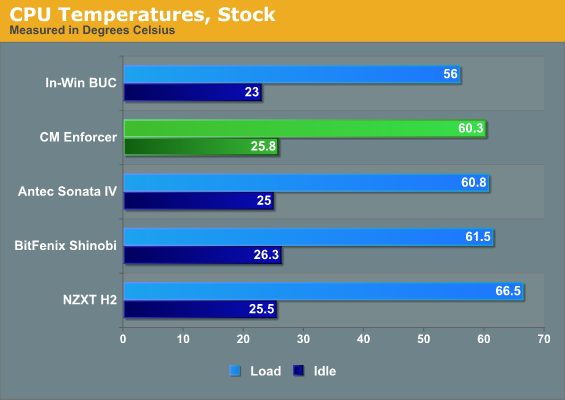
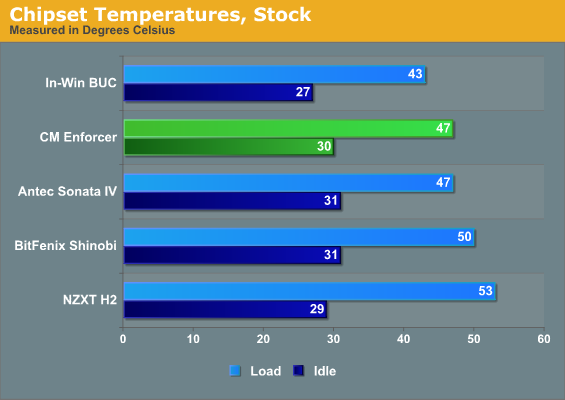
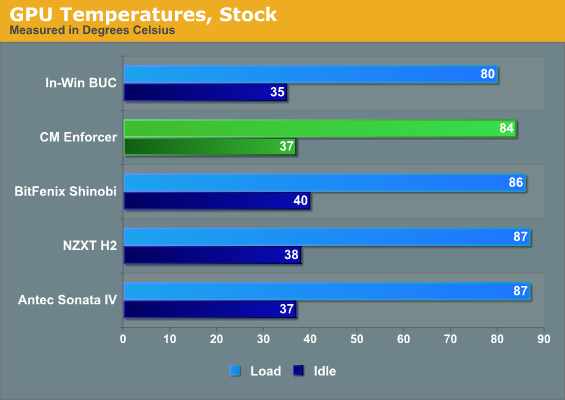
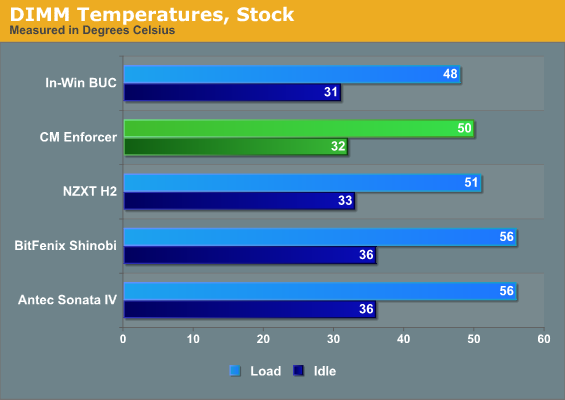
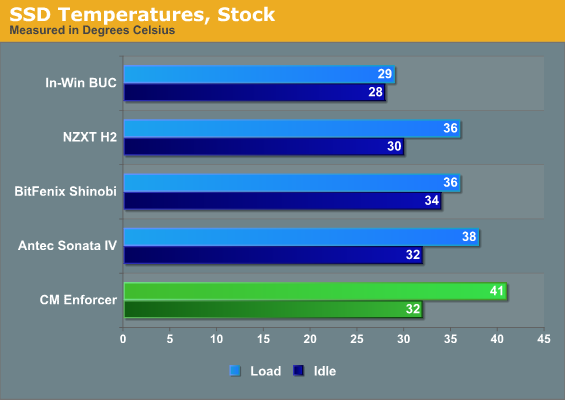
Thermals remain consistently good for the Cooler Master Storm Enforcer. The In-Win BUC still does better, but the BUC has the benefits of being both larger and having a third fan, and it sells for $20 more than the Enforcer. The SSD temps are the worst of the lot, but still within spec; using the included adaptor and moving the SSD into one of the 3.5" bays would probably even that out, as it currently sits at the bottom of the case next to the power supply.
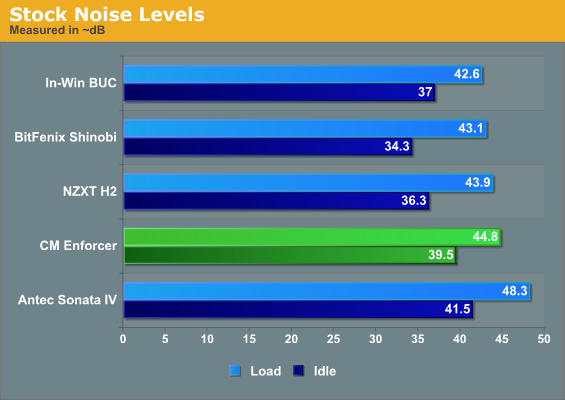
Unfortunately, the Enforcer has to run pretty loud to hit those thermals. While it's not as bad as the Sonata IV (at its medium setting), it's worlds away from the more expensive BUC while the Shinobi seems to offer the best balance of idle and load noise.
Noise and Thermal Testing, Overclocked
Our overclocked settings have thus far been absolutely punishing for the cases we've reviewed; cases without sound suppression features get brutalized once the overclocked i7-875K is put under load. Moving into these settings, I was hoping the Enforcer would be able to handle the increased thermal load without having to ramp up as much as the other cases have.
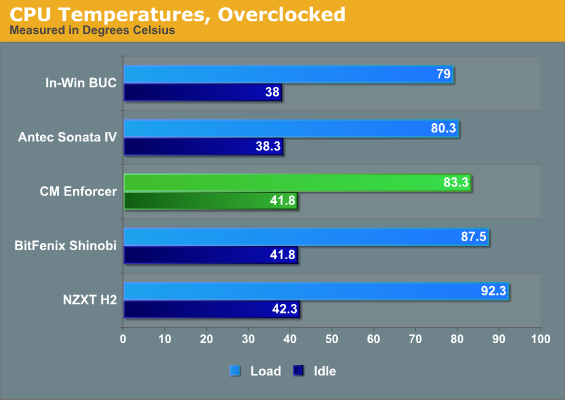
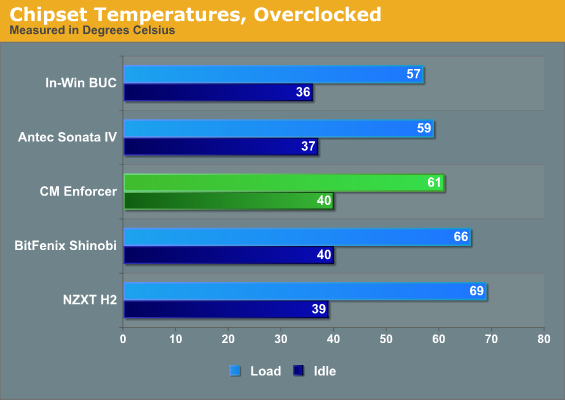
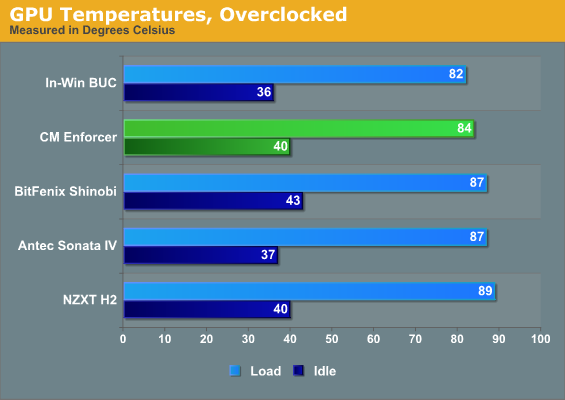
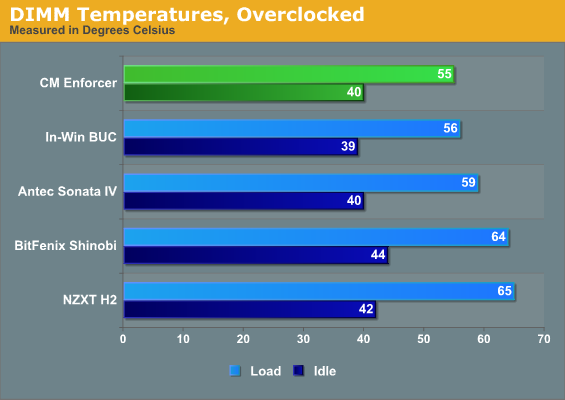
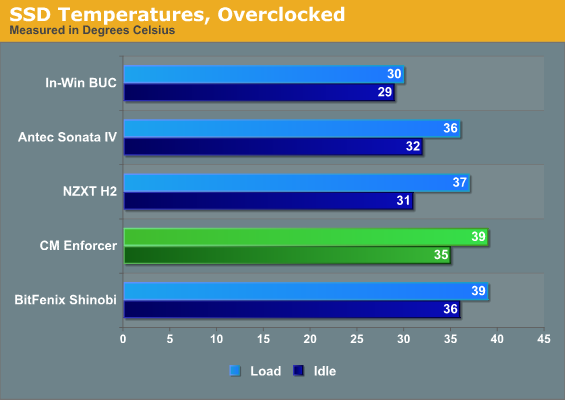
Unfortunately the Enforcer has a hard time keeping pace with the other cases. Antec's Sonata IV is nearly twice as expensive, but its internal design (though largely outdated) is simple and keeps airflow directed squarely at the processor. That single fan in the back is working like mad to remove heat, but it's working.
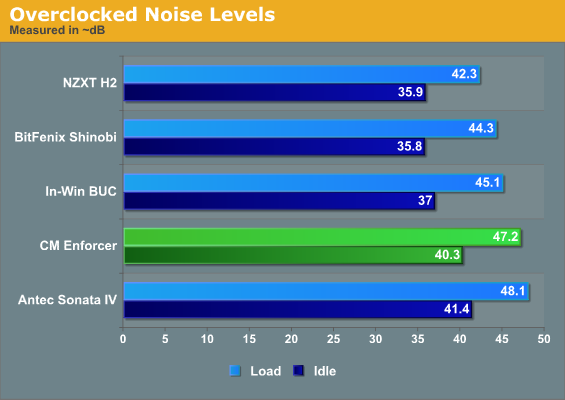
Unfortunately, the Enforcer is also one of the loudest cases, and the chart doesn't even tell the whole story. With the BIOS fan control settings we've been using, the Enforcer "breathes" at idle which made getting a good acoustic reading somewhat fraught. We can't really fault Cooler Master for settings we do control in the BIOS, but it did have to spin up and back down demonstrating substantial variance in the speeds and corresponding noise of the fans included. Either way, though thermal performance is good, there's a real trade-off with noise.
Conclusion: The Enforcer Has Both Sound and Fury
Cooler Master's Storm Enforcer is fairly understated compared to many gaming enclosures, and it thankfully includes most of the features of modern cases along with some smart additions of its own. Cooler Master is helping lead the way by using the USB 3.0 motherboard header instead of just a routing cable (even though an adaptor would've been appreciated), and the auxiliary expansion slot just for ports is actually a nice touch that can help you get some additional mileage out of unused motherboard headers.
At the same time, the enclosure offers solid thermal performance. It consistently placed just behind our incumbent In-Win BUC, and slightly ahead of the BitFenix Shinobi (extending its lead under overclocked settings.) If thermal performance on a budget is your primary concern, the Enforcer certainly isn't a bad choice. Unfortunately for Cooler Master, it's also not your only choice.
Part of the problem is that the Enforcer has to run louder than competing cases to get those thermal results. The BUC runs cool and quiet under any circumstances, while the Shinobi is liable to meet or beat the Enforcer's performance with an extra fan or a different internal configuration, and the Shinobi sells for at least $10 less. Where things get really sticky is when you start looking at other enclosures in Cooler Master's own lineup. The HAF 912 may not have USB 3.0 support, but it's also $10 less, boasts many of the same features, and has a legion of happy owners behind it. Personally I'd like to bring the HAF 912 in to take a look at on its own. I'm willing to bet that without the door on the front, the increased ventilation from the unused 5.25" bays pays dividends for keeping temperatures in the whole system down.
Cable management also remains a sore spot with most modern cases, and this is something I've only seen BitFenix really get right (thus far) with their Shinobi. Being able to route cabling behind the motherboard tray is fantastic and really should be standard on nearly any modern case, but the clearance behind the tray in the Enforcer is nowhere near enough and at best pays lip service to the whole notion.
The Cooler Master Storm Enforcer is by no means a bad case, but there are better options out there. The Shinobi is less expensive and in my opinion more attractive, and with some tweaking could probably post numbers comparable to the Enforcer. Cooler Master also offers the similar and much beloved HAF 912, which has many of the same perks of the Enforcer at the same price as the Shinobi. Thermals and noise indeed go hand in hand, but sometimes not in the ways you'd expect. Sometimes a 200mm fan can be too much.



















